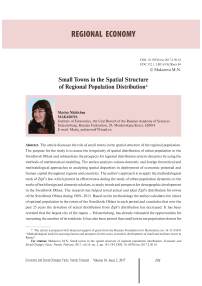Small towns in the spatial structure of regional population distribution
Автор: Makarova Mariya Nikitichna
Журнал: Economic and Social Changes: Facts, Trends, Forecast @volnc-esc-en
Рубрика: Regional economy
Статья в выпуске: 2 (50) т.10, 2017 года.
Бесплатный доступ
The article discusses the role of small towns in the spatial structure of the regional population. The purpose for the study is to assess the irregularity of spatial distribution of urban population in the Sverdlovsk Oblast and substantiate the prospects for regional distribution system dynamics by using the methods of mathematical modeling. The author analyzes various domestic and foreign theoretical and methodological approaches to analyzing spatial disparities in deployment of economic potential and human capital throughout regions and countries. The author's approach is to apply the methodological tools of Zipf's law, which proved its effectiveness during the study of urban population dynamics in the works of both foreign and domestic scholars, to study trends and prospects for demographic development in the Sverdlovsk Oblast. The research has helped reveal actual and ideal Zipf's distribution for towns of the Sverdlovsk Oblast during 1989-2015. Based on the methodology the author calculates the values of optimal population in the towns of the Sverdlovsk Oblast in each period and concludes that over the past 25 years the deviation of actual distribution from Zipf's distribution has decreased...
Small towns, population, spatial distribution, zipf's law, socio-demographic development, development disparities, sverdlovsk oblast
Короткий адрес: https://sciup.org/147223923
IDR: 147223923 | DOI: 10.15838/esc.2017.2.50.10
Список литературы Small towns in the spatial structure of regional population distribution
- Buldakova N.B. Problemy i perspektivy razvitiya malykh gorodov Rossii . Vestnik Shadrinskogo gosudarstvennogo pedagogicheskogo instituta , 2011/1, issue 1, pp. 166-169..
- Zykova N.V., Khozyainova S.V. Malye goroda v sisteme sotsial'no-ekonomicheskogo razvitiya regiona: sovremennye tendentsii i problemy . Problemy sovremennoi ekonomiki , 2011, no. 4 (40). Available at: http://www.m-economy.ru/art.php?nArtId=3837 (accessed: 20.09.2016)..
- Izard U. Metody regional'nogo analiza: vvedenie v nauku o regionakh . Moscow: Progress, 1966. 660 p..
- Kolomak E.A. Razvitie gorodskoi sistemy Rossii: tendentsii i factory . Voprosy ekonomiki , 2014, no. 10, pp. 82-96..
- Lappo G., Polyan P., Selivanova T. Aglomeratsii Rossii v XXI veke . Demoskop Weekly , 2010, no. 407-408, pp. 45-52..
- Plyusnin Yu.M. Malye goroda Rossii. Sotsial'no-ekonomicheskoe povedenie domokhozyaistv, tsennostnye ustanovki i psikhologicheskoe sostoyanie naseleniya v 1999 g. . Moscow: Moskovskii obshchestvennyi nauchnyi fond, 2000, issue 27. 147 p..
- Rastvortseva S.N., Manaeva I.V. Analiz proyavleniya zakona Tsipfa v gorodakh Rossii . Ekonomicheskii analiz: teoriya i praktika , 2015, no. 46(445), pp. 56-66..
- Selyaeva Yu.S. Formirovanie gorodskikh aglomeratsii kak instrument dinamichnogo sotsial'no-ekonomicheskogo razvitiya territorii . Inzhenernyi vestnik Dona , 2012, no. 3(21), pp. 765-769..
- Vetrov G.Yu. (Ed.). Sotsial'no-ekonomicheskoe razvitie malykh gorodov Rossii . M: Fond «Institut ekonomiki goroda», 2002. 102 p..
- Fattakhov R.V., Stroev P.V. Prostranstvennoe razvitie Rossii: vyzovy sovremennosti i formirovanie tochek ekonomicheskogo rosta. Natsional'nyi doklad . Panel'naya diskussiya «Prostranstvennoe razvitie Rossii: vyzovy sovremennosti i formirovanie tochek ekonomicheskogo rosta». 22.06.2015. Finansovyi universitet pri Pravitel'stve RF . Available at: http://fa.ru/projects/forum24/discussion/Pages/Prostranstvennoe-razvitie-Rossii-vyzovy-sovremenno.aspx (data obrashcheniya: 20.09.2016)..
- Benguiguia L., Blumenfeld-Lieberthal E. A dynamic model for city size distribution beyond Zipf 's law. Physica A, 2007, no. 384, pp. 613-627.
- Brakman S., Garretsen H., Schramm M. The Strategic Bombing of German Towns During World War II and Its Impact on City Growth. Journal of Economic Geography, 2004, volume 4, no. 2, pp. 201-208.
- Chen Y., Zhou Y. Multi-fractal measures of city-size distributions based on the three parameter Zipf model. Chaos, Solitons & Fractals, 2004, no. 22, pp. 793-805.
- Davis D., Weinstein D. A Search for Multiple Equilibria in Urban Industrial Structure. Journal of Regional Science, 2008, volume 48, no. 1, pp. 29-65.
- Davis D., Weinstein D. Bones, Bombs, and Break Points: The Geography of Economic Activity. American Economic Review, 2002, volume 92, no. 5, pp. 1269-1289.
- Mansury Y., Gulyaґ L. The emergence of Zipf's Law in a system of towns: An agent based simulation approach. Journal of Economic Dynamics & Control, 2007, no. 31, pp. 2438-2460.
- Miguel E., Roland G. The Long-run Impact of Bombing Vietnam. Journal of Development Economics, 2011, volume 96, no. 1, pp. 1-15.
- Moura N. J., Ribeiro M. B. Zipf law for Brazilian towns. Physica A, 2006, no. 367, pp. 441-448.
- Xu Z., Harriss R. A Spatial and Temporal Autocorrelated Growth Model for City Rank-Size Distribution. Urban Studies, 2010, no. 47 (2), pp. 321-335.
- Zipf G.K. Human Behavior and the Principle of Least Effort. Boston: Addison-Wesley Press, 1949. 573 p.


